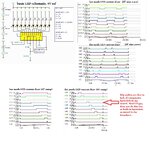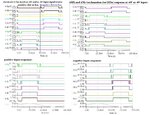d123
Advanced Member level 5
Hi,
Thanks for info. I still say that fitting two versions together may be more effort (and possibly parts) than makes sense to do virtually the same thing...
It seems there's no spice/simulation model for the LM3914 so out of curiosity I've been trying to make one that is adequate for simple simulation purposes to test theories.
So far I have a bar mode one working; thanks to KlausST's help I've been able to make the dot mode version. Fitting them together was a bit of a challenge and I had to pause the fun due to other commitments. I feel the provisional model is 2 steps from being usable but time is an issue for me right now. If I can find a minute on Sunday night I'll get back to the model so maybe Monday or later in the week we can see how the circuit I posted, and I have a more complete version of that now, too, fit together. I'd need to re-calculate some resistor values and so on.
I work and have other commitments so do not lead a life of leisure with endless free time, quite the opposite, so please bear that in mind...
Important to remember that first is idea converted to a design and then some maths, after simulation and/or breadboarding comes prototyping to correct (hopefully minor) discrepancies between simulation results and reality. This is a circuit you can make on a breadboard with PDIP parts and smooth out rough edges or flaws and quirks before making a soldered version.
Hope to get back to you soon!
Thanks for info. I still say that fitting two versions together may be more effort (and possibly parts) than makes sense to do virtually the same thing...
It seems there's no spice/simulation model for the LM3914 so out of curiosity I've been trying to make one that is adequate for simple simulation purposes to test theories.
So far I have a bar mode one working; thanks to KlausST's help I've been able to make the dot mode version. Fitting them together was a bit of a challenge and I had to pause the fun due to other commitments. I feel the provisional model is 2 steps from being usable but time is an issue for me right now. If I can find a minute on Sunday night I'll get back to the model so maybe Monday or later in the week we can see how the circuit I posted, and I have a more complete version of that now, too, fit together. I'd need to re-calculate some resistor values and so on.
I work and have other commitments so do not lead a life of leisure with endless free time, quite the opposite, so please bear that in mind...
Important to remember that first is idea converted to a design and then some maths, after simulation and/or breadboarding comes prototyping to correct (hopefully minor) discrepancies between simulation results and reality. This is a circuit you can make on a breadboard with PDIP parts and smooth out rough edges or flaws and quirks before making a soldered version.
Hope to get back to you soon!



